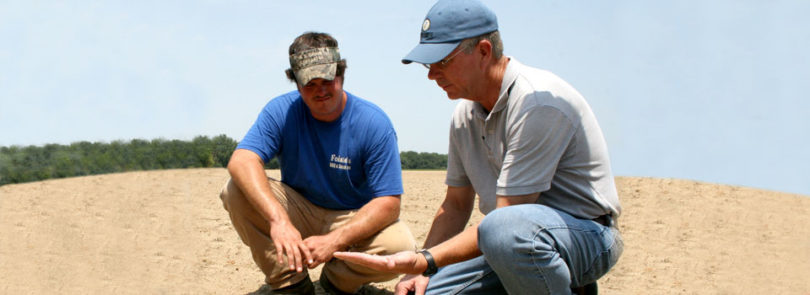The cotton seedling tried. But after sending its taproot more than five inches deep into the parched dirt, searching for moisture, it gave up and died. “Some of (the cotton) sprouted and came up in places that had enough moisture for it to come up. … But it’s gotten so hot and dry now that it just killing it. When it’s breaking the dirt, it’s dying,” said Kyle Pollock, a 26-year-old Mitchell County farmer in southwest Georgia, holding the cotton seedling in his hand.
In an area of the state that hasn’t had “a good rain” in more than two months, Pollack runs his irrigation systems nonstop to keep his corn, cotton and peanuts alive. What he can’t irrigate, he said, “is pretty much gone.”
His 100 cows usually eat grass in his pasture this time of year. But the pasture has been brown for weeks. Instead, they are eating the last bales of hay Pollack saved from last year. He’s going to have to buy more hay or start selling off his herd.
Pollock’s situation in Mitchell County is not isolated. Since the end of May, conditions in the southern two-thirds of state have deteriorated from extreme to exceptional drought, the highest drought category. And portions of northwest Georgia have now entered moderate drought conditions, said David Stooksbury, Georgia’s climatologist with the University of Georgia College of Agricultural and Environmental Sciences.
“Streams flows across the southern half of the state are extremely low. … Groundwater levels in the coastal plain are at or near record low levels for all long-term monitoring wells. Some communities in the region are drilling deeper wells to maintain water supplies,” Stooksbury said. The corn situation is “really bad,” said Dewey Lee, an agronomist with UGA Cooperative Extension. Corn that hasn’t had irrigation water applied to it isn’t going to survive, except in some of the north Georgia counties that have received rain. Even with irrigation, some farmers are struggling to provide fields with enough water to reach high yields.
“Water supplies are tightening in Georgia and, unfortunately, a large portion of the corn crop is at the most critical stages of water demand,” Lee said. “It is still dry and very hot. Any stress now guarantees some yield loss depending on the length of the plant stress and its growth stage.” One-third of the state’s corn crop is in poor to very poor condition, according to a June 13 report by the Georgia Agricultural Statistics Service, or GASS.
“The drought is having a significant negative impact on our cattle industry,” said Curt Lacy, a UGA Extension livestock economist.
Normally, cattle feed off pasture grass during summer. But 70 percent of the state’s pastureland is rated poor to very poor, according to the GASS report. This means there isn’t enough grass for cattle to eat. Cattlemen are feeding baled hay to their herds, something they typically only do during winter when pasture grass is dormant. It’s costing them, Lacy said.
On average, it costs 50 cents per day to feed a cow for one day when pastures are in good condition. It costs $1.50 per day to maintain that same cow with just hay during drought conditions.
“And, remember, that during droughts like this, the economic effects persist long after it starts raining again,” Lacy said. “Cows have trouble conceiving or they abort. Cattle are more susceptible to diseases.”
According to the GASS report, one-third of the peanuts in the state are in poor to very poor conditions. Almost half of the cotton crop is in poor to very poor condition.
Just six years on his own as a farmer, Pollock has been hit twice by crippling drought. In 2007, the state – as it is now – was in the grips of record-setting dry weather, which doesn’t seem like that long ago, he said.
“It really is discouraging,” Pollock said. “You put all this hard work and time in to it, and it burns up. … Makes me wonder if I want to keep on trying to do this.”





